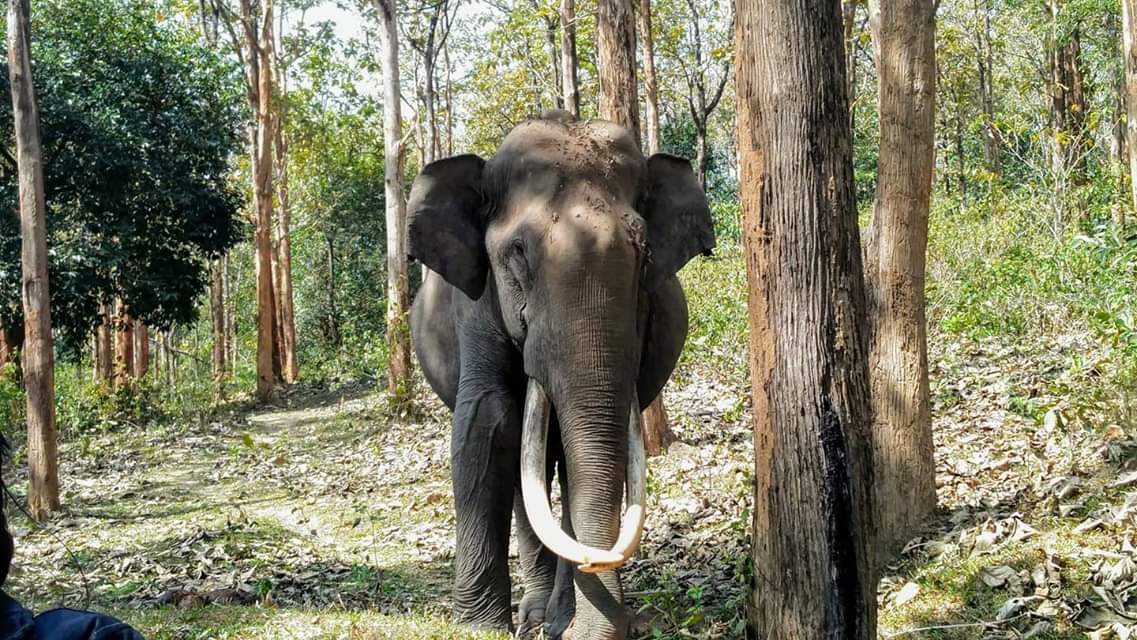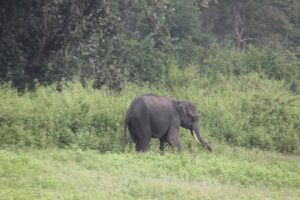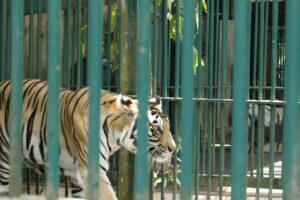Irulam village in Wayanad is yet to recover from the untimely death of its favourite pet — a genial wild elephant called Maniyan.

Maniyan in his good old days in Irulam. Photo: K A Shaji/ The South First.
Standing tall at over nine feet, Maniyan was incredibly huge and imposing. He had his long overgrown tusks crossed, which appeared to have imprisoned his ground-hugging trunk.
Questions were raised over his ability to feed himself from across the state. Many felt that his crossed tusks were preventing him from feeding.
The poignant questions made the Kerala Forest Department watch him closely. He can feed, the department announced after monitoring him for days.
The realisation that he could survive made wildlife enthusiasts happy. The happiness, however, was short-lived.
On 8 September, 2018, the pachyderm, aged around 40, was found gored and dead near the Pullumala forest range in the Wayanad district.
The carcass bore injuries, indicating a fight he had had with another wild tusker.
Though strong and healthy, Maniyan was peace-loving and uncannily gentle. He didn’t fight the fight —, for mating rights — the way it ought to be, and got fatally gored in the forehead, chest, and stomach.
Veterinary surgeon Dr Arun Zachariah, who conducted the post-mortem examination, confirmed this. A report quoted him as saying that Maniyan had not retaliated when attacked on that fateful Saturday.
Maniyan was a beacon of harmony, friendship, and affection. He was Wayanad’s pride. He was the son of the Sahyas, the Western Ghats.
A wild elephant, Maniyan was an integral part of Wayanad’s rich biodiversity. His premature death plunged several villages into grief. Hundreds of people, especially from low-income families in Irulam village, gathered for his cremation but were prevented by the authorities from entering the deep forest.
He was their son, a pet, and pride. Social media made him dear to people elsewhere in the state. They all mourned his unnatural death. Newspapers ran obits, which were paeans in honour of the tusker.
On 10 September, 2018, several condolence meetings were held at Irulam and nearby villages located on the fringes of the Wayanad Wildlife Sanctuary. Hundreds of mourners attended the meetings.
Silent processions were taken out in Irulam, Pulpally, and Sulthan Bathery, mourning his death, and in reverence of the genial friend.
The mourning was strange, for Wayanad has been a man-animal conflict zone. Yet, Maniyan stood apart, aloof from other marauding wild herds. He avoided the forests, but for occasional visits, like his last — which left a jumbo-sized void in the hearts of several people.
Munnar’s much-vilified wild tusker Arikomban, too, prefers the grasslands and human habitations to the shola forests or the tropical rainforests.
Arikomban, aged around 35, is also Sahya’s son — in a way, Maniyan’s younger sibling.
Vested interests, especially resort and land mafias, have now unleashed an unbridled campaign to relocate Arikomban and keep him in eternal captivity, despite the High Court of Kerala, on Wednesday, 29 March, appointing a five-member expert committee to find alternatives.
Social media posts, saying “we, the people of Idukki, know how to kill an elephant”, too, have appeared, indicating that Arikomban will be eliminated at any cost.
The villagers in Wayanad are still mourning Maniyan. Their dream of installing a statue of the genial giant at Irulam is yet to materialise.
They need help with the memorial. The villagers have already approached the state Forest Department, and a fundraising initiative will be launched soon.
The plan is to build a larger-than-life statue of Maniyan in the village in another six months.
Usually found between Sulthan Bathery and Pulpally in Wayanad, Maniyan co-existed with humans for more than 30 years.
He was friendly even to strangers, welcoming them, waving his huge winnow-like ears. He was a common sight on the Sulthan Bathery-Pulpally state highway, which passes through Irulam. He did not raid crops or attack humans.
Pulpally-bound motorists had frequently reported seeing the giant standing by the road calmly for hours, accepting fruits and vegetables from local farmers and passersby.
Wayanad has a strong forest cover, and human-wildlife conflicts are frequent. For the farming community, crop-raiding wild elephants have always been their foremost enemy.
Wildlife offences were high in Irulam and the neighbouring villages abutting the forest, and local poachers had always targeted elephants.
Maniyan was an exception. He shared a rare camaraderie with villagers in Irulam, Kurichiad, Chethalayam, Moonnanakuzhy, and Kuppadi.
Maniyan was a part of village life. Scores of wailing women and children braved torrential rains and rushed to Pullumala on learning about his death — for a last look at their beloved elephant.
For them, the dash toward Pullumala marked the end of an unforgettable episode in their lives.
“He might be the lone wild tusker that enjoyed celebrity status in Wayanad. In a way, he had more fans than the celebrated temple elephants of Kerala,” M Kunjunarayanan, a farmer at Irulam, who still mourns the death of one of his “children”.
Domesticated elephants are Kerala’s weakness. But not those in the wild. Maniyan was an exception.
“Maniyan always created headlines in Kerala. Many videos circulated on social media made him popular across the state. He never intimidated anyone. Relishing bananas and other fruits offered by passersby was his favourite pastime,” he added.

A wild elephant inside the Bavali forests of Wayanad. (KA Shaji/South First)
According to Forest Range Officer P Ratheeshan, Maniyan was instantly recognised, thanks to his overgrown tusks that crossed each other at the tip.
Irulam village resident P Chandran said the elephant was even responsive to the farmers’ calls. It had always remained fond of bananas, jackfruit, and jaggery offered by the residents.
Forest officials said Maniyan was always vulnerable to attacks by other wild elephants, especially herds.
They attacked Maniyan whenever he went deep inside the forests during the musth (mating) period.
Like the residents of his chosen village, he never attacked other elephants. In the absence of a counterattack, he used to return “home” from the forests with deep gashes. Still, he did not complain.
Forest Department veterinary surgeon Dr Zachariah, said the department had tranquilized Maniyan three times to take care of the injuries. For over five years, he remained radio-collared, with the Forest Department officials monitoring his movements.

A Kattunayaka family living in Noolpuzha forests in Wayanad. (KA Shaji/ South First)
“At a practical level, he was not a wild elephant. Maniyan preferred to live among us as our preferred pet than go inside the deep jungles,” KV Biju, a resident of Irulam, told South First.
“Maniyan was extremely friendly and affectionate. He ate whatever we had offered,” he recalled with a heavy heart.
“He was a classic example of co-existence. Whenever they found the elephant injured, the people alerted us and ensured that he got the best medical care,” Dr Zachariah said.
In November 2017, Maniyan became the subject of a unique social media campaign.
The viral campaign urged the FoDdepartment officials to trim his overgrown tusks as they were hindering free movement and preventing him from feeding well.
Though he was put under observation following the campaign, the elephant was found to be in good health.
Despite the elongated tusks, Maniyan was found feeding on his own.
“The Forest Department chose not to interfere and trim Maniyan’s tusks. We wanted to avoid human intervention on wild animals as much as possible,” Wayanad Wildlife Sanctuary Warden NT Sajan recalled.
Only the tusks of captive elephants were trimmed. It was not done in the case of wild elephants as it would disrupt the natural selection process, he told South First.
In 2017, forest officials had to tranquilize the tusker to remove a snare stuck to its leg. But even that snare was not targeted at him.

A tiger was captured recently in Wayanad. Photo: Pratheesh Cheeral
Marauding elephants and tigers are a matter of concern for Wayanad’s farmers.
Wayand grabbed national attention after senior Congress leader Rahul Gandhi contested to the Lok Sabha from there.
The district, however, has a long history of man-animal conflicts.
Ninety-six human settlements, including Kurichiad, are located in the 354 sq km sanctuary, and foraying tigers and elephants have been creating a scare in the region.
Last year alone, four persons were killed in tiger attacks in Wayanad. Tigers were sighted close to highways and residential areas in recent months.
Still, Maniyan stands tall as a testimony to wild animal-human co-existence.

Apr 17, 2024

Apr 17, 2024

Apr 16, 2024

Apr 16, 2024

Apr 15, 2024